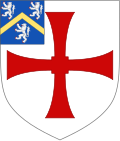The building
Archdeacon's Inn was built around 1700, [1] as a city residence for the Archdeacon of Northumberland, who administered the Northern part of the Diocese of Durham (which in 1882 would become the Diocese of Newcastle). [3]
In 1833, the building was given to the University of Durham as the home of University College and the residence of the university's first students.
The Students' Apartments are in the Archdeacon's Inn, on the Palace Green
—
First Calendar of the University of Durham, 1833 [4]
The first students took residence in Michaelmas Term 1833, under the supervision of the Bursar. A hall was created on the ground floor of the house, with student rooms above and below. [4]
The building subsequently became known as "University House".
In 1837, Durham Castle was granted to the university and became the primary home of University College, with University House being retained as additional accommodation for the college. [4]
Foundation of Bishop Cosin's Hall
In 1846, David Melville opened Bishop Hatfield's Hall, initiating the pioneering practice of letting rooms furnished and serving food communally at a fixed price. This was intended to make university attendance far more accessible to students of limited means, compared to University College and the colleges of Oxford and Cambridge, where students were expected to furnish their own rooms and to engage servants to prepare their food. [5]
The high level of applications for admission to Hatfield Hall led the university to decide to establish a second hall to operate on the same basis, and in October 1851 Bishop Cosin's Hall was opened. [5] Its name was in honour of John Cosin, Bishop of Durham 1660–72, [5] and it is recorded as having used his heraldry. [6]
University House was transferred from University College to the new college as its home. The founding principal was Revd John Pedder, a Durham graduate who had previously been bursar at University College. [7]
In 1854 Pedder moved to become principal at Bishop Hatfield's Hall, and his place was taken by 28-year-old Revd James John Hornby, a fellow of Brasenose College, Oxford and a noted rower. [8] From 1859, Hornby was also vice-master of University College. [4]





